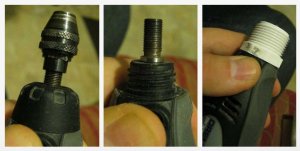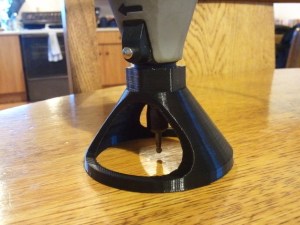
Dremel rotary tools are handy. Some of the attachments are convenient. [vreinkymov] felt the convenience wasn’t worth the cost, so he decided to make a Router Base for his Dremel. These types of attachments are used to hold the Dremel perpendicular to the work surface.
Underneath the little nut/cover near the spindle of the Dremel, there is a 3/4″-12 threaded feature used to attach accessories. A quick trip down the hardware store’s plumbing aisle resulted in finding a PVC reducer with the correct female thread to fit the Dremel. Once on the rotary tool, the reducer threads into a PVC nipple that is glued to a piece of acrylic. The acrylic acts as the base of the router attachment.

 Dremel’s official router base is called the 565. It slides up and down to adjust the bit height and locks with a thumb screw. [vreinkymov]’s design utilizes the threads of the reducer and nipple to allow height adjustment. If those threads get a little loose, it would be possible to drill and tap a hole for a thumb screw that would prevent the reducer and nipple from turning in relation to each other.
Dremel’s official router base is called the 565. It slides up and down to adjust the bit height and locks with a thumb screw. [vreinkymov]’s design utilizes the threads of the reducer and nipple to allow height adjustment. If those threads get a little loose, it would be possible to drill and tap a hole for a thumb screw that would prevent the reducer and nipple from turning in relation to each other.
Those with access to a 3D Printer may be interested in this router attachment hosted on thingiverse.com. The height is not adjustable but otherwise it appears to be pretty nice.
















Dremel != router
Use proxxon, kress or any other proper tool.
Oh of course. As soon as you show me where I can buy a Proxxon Kress or any other proper tool for $5 which is about how much it would cost to get this attachment made and start routing.
This kind of tool is when you need to make one cut every couple months. Most of us cannot justify – or afford! – the right tool for the job, so we use the best we’ve got. Dremels at least are designed for off-axis loading, so it’s probably the best we can do.
That’s kind of the drive for a good 95% of hacks, isn’t it?
I made a dremel-router attachment a number of years ago as an aluminum foundry project:
http://www.dansworkshop.com/2008/03/sand-castings-and-patterns/
The dremel plastic one is actually cheaper than making one yourself, and you get 2 router bits with it, so your hack is more of a worthwhile thing since it’s metal.
However this featured project has it’s own charms in seeing how he went about it and it can be used as a basis for your own dremel mods
@Whatnot – agreed, I just love that pipe-thread to dremel adaptation. I’m still waiting for my USB-to-garden-hose adapter converter. ;)
The 565 (which is actually not a router attachment, but more of a Rotozip spiral saw type attachment) is about $15. The actual plunge router attachment is $26.
But, the useful part of this is learning about the PVC reducer that fits on the dremel.
The actual ‘cup’ is identical though as far as I can tell,. and the bits work on plasterboard and wood.
Does anybody make a BLDC type of moto-tool? The Dremel of 30 years ago was better, DC magnet design. The current design is a throwback to the universal of a century ago. The absurdity of running a DC motor on AC, hum-whine! A modern design would fit within your hand.
Hitachi makes a few cordless BLDC tools.
I think this is interesting. Not that I need a router flange or anything like that, because I managed to get the Dremel branded one thrown in with one of their rotary tool bundles.
I really didn’t consider the thread to be something that could be used with an off the shelf coupler. To be able to make any kind of arbitrary custom attachment inexpensively is a big help. I just assumed it was some oddball thread that wasn’t compatible with anything, without really checking.
And yes, we probably should get better tools, but I bet most of these rotary tools are used less than an hour a year.